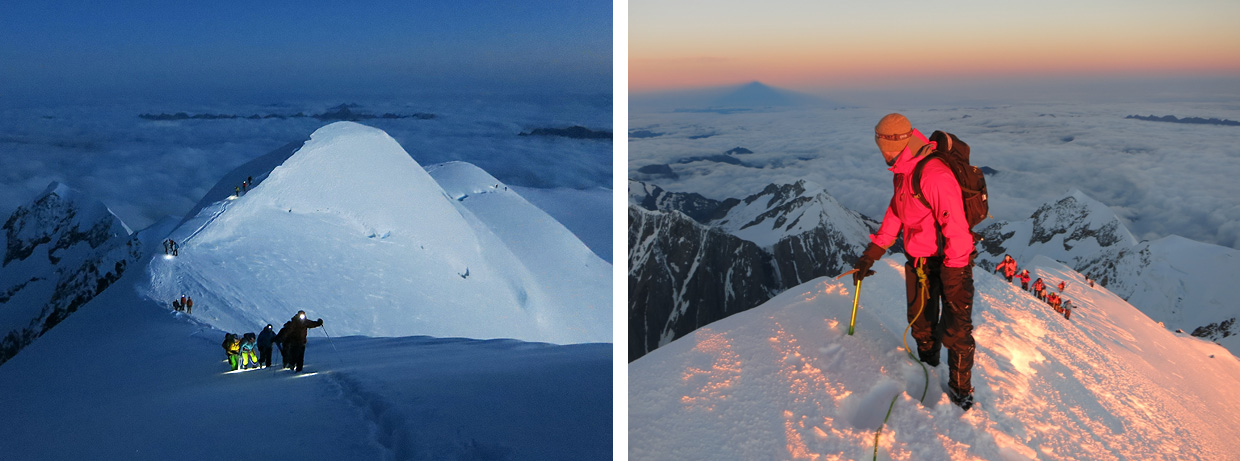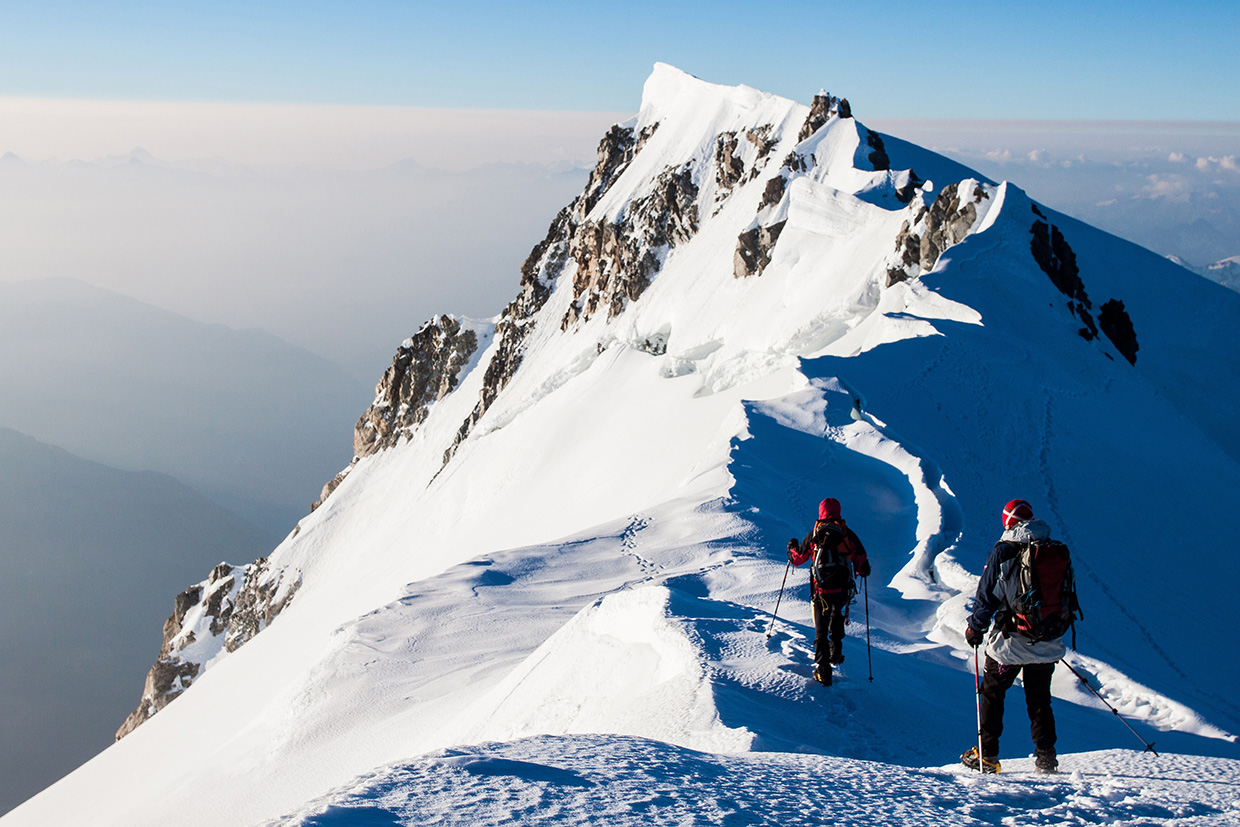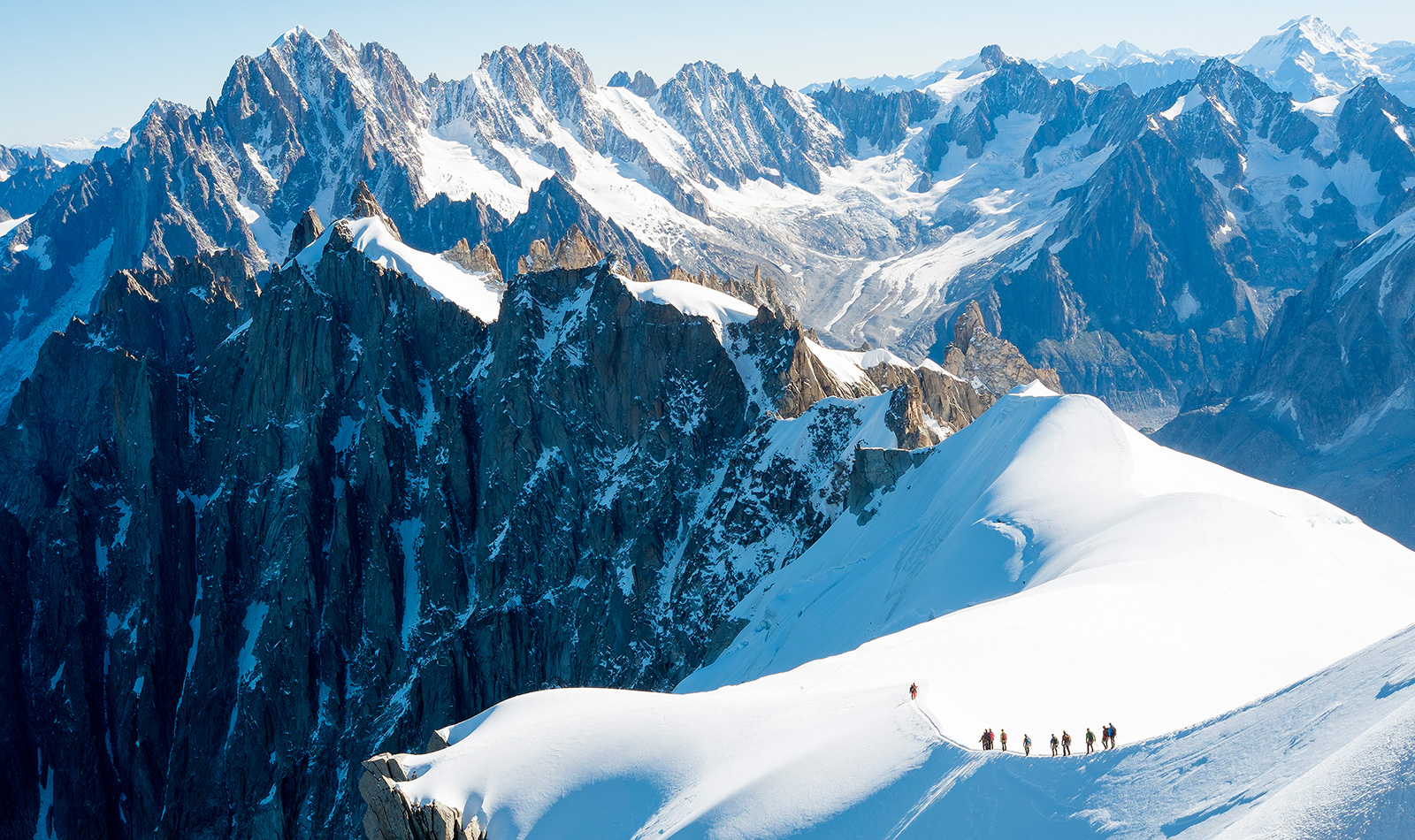New Heights
Discovering the Magic of Mont Blanc
Katy Dartford
There are many ways to summit a mountain if you’re a 21st century alpinist. I’ve heard talk of climbing Mont Blanc three different ways in three days, of walking all the way up from the Chamonix valley – or if you’re the Catalan ultra-marathon runner Killian Jornet, you can run up and down in 4 hours and 57 minutes. Or why not just knock off all 82 peaks over 4,000m in Western Europe in one summer like Ueli Steck?
This year Chamonix has been celebrating 150 years since the Golden Age of Alpin-ism which reached its climax in 1865. It was an eventful year which saw 65 first as-cents in the Alps – seven of these in the Mont Blanc massif, including the Aiguille Verte, Grandes Jorasses and the Brenva Spur. But Mont Blanc hasn’t always been a tick on a bucket list. Only 80 years before, the mountain was unexplored ground. Guides believed the route to be impossible and the motivations to climb it were fi-nancial and scientific. But in 1786, the success of two Chamoniards, Jacques Bal-mat, a guide and crystal hunter, and Doctor Michel Paccard, changed everything.
On the 150th anniversary of this golden age, Chamonix has seen one of its worst summers for mountaineering due to soaring temperatures. Mont Blanc has been out of condition since early July, and gendarmes have set up camp by the Grand Couloir to stop anyone crossing it and proceeding to the Goûter refuge – where most people spend the night before making their push for the summit – which has closed its doors for the first time in history.I felt lucky, then, that I attempted Mont Blanc, my first alpine-style 4,000m peak, last year. I’d wanted to tackle Europe’s most coveted summit the ‘easy’ way, with a week to get acclimatised and make sure my skills were up to scratch. No such luxury for Balmat and Paccard: they had no rope or crampons, and took 14 and a half hours of constant climbing with Paccard’s heavy scientific equipment to reach the summit. I kept this fact in mind as I winced under the weight of my pack.
I went to meet our Catalan guide Fabio, who was with Adventure Base, for our kit check. My backpack had the essentials of crampons, boots, helmet, harness, various layers of clothing. Should I bother with spare underwear, I wondered, for our over-night in the mountain hut? I didn’t dare ask.
There were four of us in the group that assembled in Chalet Viper, Chamonix, to meet Fabio. With me were friends Johnny and Emily, who had never done any mountaineering before, and Flavia, from Italy, who had climbed a few peaks. Fabio cast a withering eye over our possessions, then Johnny uttered what was on my mind but I didn’t dare ask.
‘Do you need me to tell you if you should take boxers?’ Fabio spluttered.

The heavens decided to open as we took a short cable car ride from Le Tour, at the end of the valley. Our destination was the Albert Premier hut at 2,700m for some ice axe and crampon instruction on the glacier and to start our acclimatisation. The final leg up to the hut was a good test to see how we would fare on steep terrain, and Johnny began to struggle under the weight of his massive pack. When we finally reached the hut, Fabio emptied it out – boxers and all – and cut his kit in half.
After lunch we headed out for some glacier training. First lesson: put your crampons on properly. It’s unpleasant and dangerous having them fall off as you run down an icy slope, as both Emily and Johnny found out! Crampon back on boot, we then practised some ice climbing out of a crevasse – although Mont Blanc doesn’t really need anything this technical – before Fabio took us on a little walk around the glacier, each tied into a rope with a few metres between us, so if one of us falls into a crevasse, the others can pull us out.
It was a taste of the real thing, and enough to give us nerves over what lay ahead as we head back to the hut for dinner. At 7.00pm the guardian serves us some hearty fare consisting of a lot of cheese and potatoes. Chatting over a chocolate mousse, Fabio tells us he’s not interested in 8,000m Himalayan peaks: ‘too much waiting around … in Peru, for just 300m less you can climb something in the Cordillera Blanca range in much less time.’ To really be considered a mountaineer he also reckons you must be able to ‘do something like the Aiguille Verte’, one of the most difficult 4,000m peaks of the Alps. Soon after dinner we head off to our bunks and the choir of snoring begins.After what seems like just a few restless hours of sleep, the morning flurry of activity begins. The others are irritable; I can feel the stress levels of our group rising. Finally kitted up, with many more layers than I need, we set out into the night, following twinkling head torches from the earlier risers. It’s a long slow snow plod up the Tour glacier and below I can see Chamonix sleeping. Gradually, a few patches of pink and orange rise from behind the peaks. As I watch the sun come up I feel all my stresses peel away. I’m totally absorbed in the present, rather than past and future concerns – it’s probably why I’ve become more attached to the mountains and their life detoxing effect. We eventually reach the Petit Fourche at 3,520m, it’s windy but doable, and we managed a fun scramble up its rubble of rocks, roped up and moving together. We high-five when we reach its jagged summit.
We head down towards the Trient hut, now dripping with sweat in the morning sun, and take an abseil down a ridge that leads to some avalanche debris. I untie from the rope a little early and end up sliding on my backside through most of it. The Trient hut is very different to the modernised Albert premier – rustic and cosy – and I slept pretty well, clearly more tired and acclimatised. The next morning we head across the snow, crunching through what feels like stale meringue, towards the jumble of rocks that make up the Aiguille du Tour. But we aren’t alone. Scores of people are also using it to train on, so we get in line and head up. It’s busy but beautiful and I like the sense of camaraderie. We then head back to Chamonix, heavy legged and all chattering excitedly, wondering if we are now ready for the big one.
There are several classic climbing routes to the summit of Mont Blanc. The historic route taken by Balmat and Paccard, the Grand Mulets, is now mostly traversed in winter by ski mountaineers. We are to go by the ‘normal’ or Goûter Route, consid-ered the easiest. Fabio decides that he will take me and Emily straight to the higher Goûter hut, whilst another guide will take the others to the lower Tête Rousse hut for the night. This is better in one respect as it allows you to cross the Grand Couloir in the cool of the night, so there’s less chance of rockfall, but on the other hand it adds around three hours of uphill to your summit day.

We start early, catching the lift at the Bellevue cable car from Les Houches to get the first train from the Tramway du Mont Blanc to the Nid d’Aigle at 2,372m. Here we join the throng on a very steep walk along a twisting path. It’s a hot day, but not unbearably so, and before we know it we reach the Baraque Forestiere des Rognes, a small, unmanned hut. Here we put our crampons on and rope together to head across the Tête Rousse Glacier towards the Grand Couloir.
The couloir looks fairly innocuous, but it’s actually the most dangerous part of the ascent to the Goûter hut as there can be some serious rockfall. Fabio reassures us that’s its fine, ‘but if I say run … run.’ We scuttle across, watching the snow-dashed rocks above for any debris spinning down towards us, but the Grand Couloir passes without incident.
When we reach the Tête Rousse hut we see the breathtakingly steep rock face that stretches a couple of thousand feet above the refuge to the Goûter hut. For me, this is where the fun really begins – scrambling up the ridge, following the crampon scratches and splashes of red paint marking the way up the rocks. The scramble is not as steep or hard as it looks from below. We move fast and manage to pass plenty of people by going off path a bit. As Fabio says: ‘The art of climbing is the art of avoiding people.’ At roughly 3,600m there are cables bolted to the rock which we use as hand rails, and patches of ice make me glad I’d decided to leave my crampons on.
Finally we reach the space-age new Goûter hut. It’s an impressive building: a four-storey, egg-shaped wooden structure, clad in stainless steel. Part of it juts out from the cliff over a 1,500m drop. After taking photos here to scare my mum, we demolish our sandwiches and debate whether to attempt the summit today. ‘It’s equally as good at sunset as it is at dawn,’ Fabio says, ‘and the weather looks good.’ But the forecast is better than expected tomorrow, so Fabio decides there’s no point overdoing it and instead we rest. I’m tired but feel good enough to push on if we’d decided to. After another hearty dinner I head to my bunk, but I can’t sleep – I’ve come to the conclusion its always going to be near impossible the night before a summit attempt, so instead I listen to music and try to think of it as simply ‘resting’.
A flourish of activity begins at 1.45 am. We drag ourselves down to a breakfast of heroes, and feast on hot chocolate and bread. We then kit up and set out into the night to follow a steady stream of head torches – climbers, like rows of ants, ascending towards Mont Blanc.
Fabio goes off at a pace and we overtake quite a few groups. My calves are screaming at the steepness and I try to alter the position of my steps, sometimes sidestepping, to give them some reprieve. There’s not much to see yet so we just plod on, snowy hump after snowy hump, our crampons crunching in the frost-hardened surface. Time seems to just melt away again as we climb, stopping only once for some hot sweet tea. Little patches of orange begin to emerge behind the rocky needles and arêtes. It’s beautiful and very peaceful above sleeping Chamonix.
The real test for me begins now, at over 4,500m. I’m struggling with the intense cold in my hands and for the first time I actually think I might not be able to do this. The hot aches kick in as I swing my arms round and round, trying to force the blood back to my fingers. The pain brings tears to my eyes, but we carry on trudging in zigzags, negotiating the sharp rolling ridge of Les Bosses. The sun begins to rise, made stunning by the sparkling cloud and snow billowing up off the mountain.
Then, quite suddenly, the ridge opens out. A short walk and we are on the top of Mont Blanc and, surprisingly, it’s just the three of us here. Being on the highest point in Western Europe is not what I’d expected; the summit is a dome of ice and snow that just comes to an abrupt end. A little underwhelming perhaps, but around us we can see right across Savoie and the main summits of the Alps, the Jura and even the Vosges. When it finally sinks in that we are here, tears spring to my eyes. I high-five and hug my teammates, and despite my freezing hands, no pain on Earth could stop me taking a few selfies. But we barely have a few minutes before Fabio sweeps us off back down the mountain.
To says climbing Mont Blanc is a walk in the (snowy) park is a little misleading. If you are capable of some strenuous British hill walks, its definitely doable – as long as conditions are good, you’re acclimatised and used to a certain amount of exposure – but nowadays, it’s arguable that you could say the same for Mount Everest. If you want to do it without a guide it’s a different matter. Decision-making and having the skills to keep safe and get out of trouble are all about experience.
As I returned home, I felt bereaved. I missed my group I’d spent all of every day with and the little bubble we’d been in, separated from the ‘real world’, where walking, talking and eating were the only distraction.
I hadn’t particularly thought about the significance of the 8th of August as I read about the Golden Age of Mountaineering, but then I realised that we summited on the same day as that first recorded ascent by Balmat and Paccard, 229 years ago, and I knew that somehow it had been an extra-special day.



